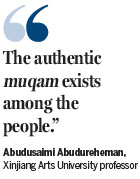

By Chen Nan Updated: 2017-05-11
Muqam is facing a threat to its existence, but efforts to revive it are in progress. Chen Nan reports.
It was a brilliant evening. Onstage, with the dutar and the tanbur (both traditional Uygur plucked-stringed instruments), Abduweli Sataer and Alipu Sedike, two musicians from the Xinjiang Uygur autonomous region, showcased unusual sounds in the concert hall of the Central Conservatory of Music in Beijing.
"My heart was stolen by a girl. She broke my heart," sing the duo in Uygur with the audience clapping to the beat.
Later, they were joined by singer Ayixianmugul Mxmet, and instrumentalists Abduklimu Usman and Ahmetjan Mehmet, and perform folk music from Xinjiang, including songs like Uergulai and There Is No Moon in Your Sky.
The artists are teachers at the Xinjiang Arts University and what they performed that night is muqam, a traditional type of music from Xinjiang.
"If you spend only one night in Xinjiang, one way to enjoy authentic Uygur culture is to take in a muqam performance. It has a wide range of musical content, choreography, musical styles and instruments," says Abudusaimi Abudureheman.

?
The Xinjiang Arts University professor, who is both the host of the show and plays the rawap (a plucked Uygur instrument) onstage, also speaks the next day about muqam, calling for awareness of its protection. It's facing a threat to its existence like many traditional Chinese art forms.
The performance and speech are part of the inaugural Music Education Alliance Across the Silk Road conference, which was initiated and organized by the Central Conservatory of Music in Beijing from May 5 to 7.
Nearly 30 music schools from China and countries along the Silk Road, a byword for economic trade and cultural exchanges between Asia and Europe, were part of the event.
Muqam has 12 sets of melodic formulas. It was developed during the Tang Dynasty (618-906). The songs vary in rhyme and are performed by soloists as well as by ensembles.
The muqam music system developed over millennia has also led to the growth of many musical genres among the people of Eurasia and North Africa.
The United Nations Educational, Scientific and Cultural Organization included Xinjiang's Uygur muqam on its Intangible Cultural Heritage list in 2005.
Abudureheman says that muqam is an Arab-Persian music tradition and shares similarities with Azerbaijani mugham, Iranian dastgah and Uzbek and Tajik shashmaqom.
"Muqam is the result of cultural exchanges between East and West, in particular due to the Silk Road," says Abudureheman. "So, with further discussions and the sharing of information with other countries, which also have the tradition of muqam music, we will learn more about it."
Abudureheman, who was born and grew up in Urumqi, capital of Xinjiang, was introduced to music and dance at a young age as both his parents taught at the Xinjiang Arts University. Abudureheman learned muqam and a number of traditional Uygur instruments from the age of 5.
After obtaining his bachelor's degree from the Xinjiang Arts University, Abudureheman went to study in Japan and graduated with a PhD in musicology from the Tokyo University of the Arts in 2012. He then returned home to teach at the Xinjiang Arts University.
"Muqam music used to be common. At weddings, family gatherings and even ordinarily after dinner, people played muqam music - singing and dancing. Now, you can hear it only in the remote villages of Xinjiang," Abudureheman says.
"I can still recall times from my childhood when, in the spacious courtyards, public squares or houses, you were sure to find a performer of muqam. But for today's generation, it is just an art form that exists onstage."
The Xinjiang Arts University's president, Talaiti Tuerdi, says the university has remained committed to researching and preserving Xinjiang's traditional art forms since it's 1958 founding. These include muqam and meshrep (a folk tradition that involves singing, dancing, acrobatics, games and storytelling).
The university began offering a muqam major in 1996. Nearly 200 students have graduated with a bachelor's degree in the subject.
"We take students to remote villages across Xinjiang every year to collect music and learn from folk musicians," says Tuerdi.
Tuerdi also says that many traditional Xinjiang art forms were born in local houses and courtyards in particular. The outdoor spaces provide people with freedom, which inspired them to be creative.
However, with urbanization, the courtyards have been transformed into buildings, and the changed lifestyles have resulted in a decline in folk art forms.
"Though muqam is showcased by professional singers and dancers onstage now, what audiences see is just an art form produced for the stage rather than the real muqam," says Abudureheman.
"The authentic muqam exists among the people. It is not just music and dance but pure joy expressed from the heart."
Contact the writer at chennan@chinadaily.com.cn
|
Teachers from the Xinjiang Arts University perform muqam at a recent concert at the Central Conservatory of Music in Beijing. Feng Yongbin / China Daily |
(China Daily 05/11/2017 page18)